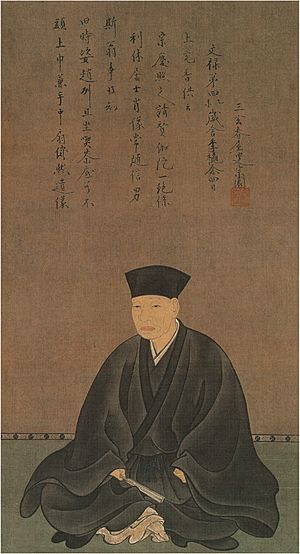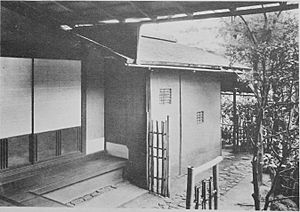Sen no Rikyū facts for kids

Sen no Rikyū (千利休), also known simply as Rikyū, was a very important person in the history of the Japanese "Way of Tea" (called chanoyu). He especially shaped the wabi-cha style. Rikyū was the first to highlight important ideas for the tea ceremony. These included keeping things simple and natural, being direct, and being true to yourself. These ideas, from the Sengoku period and Azuchi–Momoyama period, are still part of the tea ceremony today. In this article, we will call him Rikyū.
There are three main schools, or 'head houses' (iemoto), of the Japanese Way of Tea that come directly from Rikyū. These are the Omotesenke, Urasenke, and Mushakōjisenke schools. All three work to pass on the teachings of their shared family founder, Rikyū.
Contents
Rikyū's Early Life
Rikyū was born in Sakai, which is now part of Osaka Prefecture. His father was a warehouse owner named Tanaka Yohei. His mother was Gesshin Myōchin. When he was a child, his name was Yoshiro.
As a young man, Rikyū learned about tea from a man named Kitamuki Dōchin. When he was 19, Dōchin introduced him to Takeno Jōō. Jōō also helped develop the wabi style in tea ceremony. Rikyū is thought to have received the Buddhist name Sōeki from a Zen priest named Dairin Sōtō. He got married around age 21 to Hōshin Myōju. Rikyū also trained in Zen at Daitoku-ji temple in Kyoto. We do not know much about his middle years.
Becoming a Tea Master
In 1579, when Rikyū was 58, he became a tea master for Oda Nobunaga. After Nobunaga died in 1582, Rikyū became the tea master for Toyotomi Hideyoshi. His friendship with Hideyoshi grew quickly. Rikyū became one of Hideyoshi's closest friends. He was the most important person in the world of chanoyu.
In 1585, Rikyū needed special permission to enter the Imperial Palace. This was so he could help Hideyoshi with a tea gathering for Emperor Ōgimachi. The emperor then gave him the special Buddhist name and title "Rikyū Koji." Another big tea event that Rikyū helped with was the Grand Kitano Tea Ceremony. Hideyoshi held this event at the Kitano Tenman-gū in 1587.
During his later years, Rikyū started using very small, simple tea rooms. These were called sō-an, meaning 'grass hermitage'. One example is the Tai-an tea room, which has only two tatami mats. You can see it today at Myōki-an temple near Kyoto. This tea room is considered a National Treasure. Rikyū also created many tools for the tea ceremony. These included flower containers, teascoops, and lid rests made from bamboo. He also used everyday objects in new ways for the tea ceremony.
The famous Raku teabowls were created with his help. He worked with a tile-maker named Raku Chōjirō. Rikyū liked simple, rustic items made in Japan. He preferred them over the expensive Chinese items that were popular then. Rikyū did not invent the idea of wabi-sabi, which finds beauty in very simple things. However, he was very important in making it popular and bringing it into the tea ceremony. He created a new way of doing the tea ceremony using simple tools and surroundings. This style and his other ideas became known as sōan-cha (the grass-thatched hermitage style of chanoyu), or more generally, wabi-cha. This style of chanoyu was carried on by his family and followers. It became known as the Senke-ryū ('school of the house of Sen').
Rikyū was also a writer and poet. He once said about tea tools and the tea ceremony: "Though you wipe your hands and brush off the dust and dirt from the vessels, what is the use of all this fuss if the heart is still impure?"
Rikyū's Students and Family
Two of Rikyū's main students were Nanbō Sōkei, a Zen priest, and Yamanoue Sōji, a townsman from Sakai. Another student was Furuta Oribe, who became a famous tea master after Rikyū died. Nanbō is believed to have written the Nanpō roku, which records Rikyū's teachings. However, some people wonder if Nanbō really existed. Some scholars think that a samurai writer named Tachibana Jitsuzan wrote these texts. Yamanoue's book, the Yamanoue Sōji ki, shares his thoughts on Rikyū's teachings and the state of chanoyu at that time.
Rikyū had several children. His son was named Sen Dōan. His daughter, Okame, married Rikyū's second wife's son from an earlier marriage, named Sen Shōan. Because of many reasons, Sen Shōan, not Rikyū's son Dōan, became the second head of the Sen family's tea tradition.
Rikyū also wrote poetry and practiced ikebana, which is the art of arranging flowers. He was said to love the garden at Chishaku-in in Kyoto.
Rikyū's Death
Even though Rikyū was one of Hideyoshi's closest friends, they had big disagreements. Rikyū was very independent. Because of this, Hideyoshi ordered him to die. One year earlier, after the Siege of Odawara (1590), Rikyū's famous student Yamanoue Sōji was also killed by Hideyoshi's order.
We may never know for sure why Hideyoshi made this decision. Rikyū died at his home inside Hideyoshi's Jurakudai palace in Kyoto in 1591. He was 70 years old.
According to a book called The Book of Tea by Okakura Kakuzō, Rikyū's last act was to hold a beautiful tea ceremony. After serving his guests, he showed them each piece of his tea equipment. He also showed them a wonderful scroll written by an old monk about how everything changes and passes away. Rikyū gave each guest a piece of his equipment as a souvenir. But he kept the tea bowl and shattered it. He said, "Never again shall this cup, polluted by the lips of misfortune, be used by man." As the guests left, one stayed to witness Rikyū's death. Rikyū wrote his last words as a poem:
Welcome to thee,
O sword of eternity!
Through Buddha
And through Daruma alike
Thou hast cleft thy way.
The next year, when Hideyoshi was building his grand home at Fushimi Castle, he said he wished its design would have pleased Rikyū. Hideyoshi was known for his strong temper. It is said that he later regretted how he treated Rikyū.
Rikyū's grave is at Jukōin temple in the Daitoku-ji area in Kyoto. His Buddhist name after death is Fushin'an Rikyū Sōeki Koji.
Many tea ceremony schools hold yearly memorials for Rikyū. The Omotesenke school has its memorial on March 27. The Urasenke school has its on March 28. The three Sen families (Omotesenke, Urasenke, Mushakōjisenke) take turns holding a service on the 28th of every month at their shared family temple, Jukōin at Daitoku-ji temple.
Rikyū's Seven Main Students
The Rikyū Shichitetsu ('Seven Foremost Disciples') were seven important lords or generals who were also direct students of Sen no Rikyū. They were: Maeda Toshinaga, Gamō Ujisato, Hosokawa Tadaoki, Furuta Oribe, Makimura Toshisada, Dom Justo Takayama, and Shimayama Munetsuna. Rikyū's grandson, Sen no Sōtan, first mentioned this group of seven. In a list from 1663, Sōtan's son replaced Maeda Toshinaga with Seta Masatada.
Rikyū in Movies and Games
Rikyū's life and influence have been shown in many movies and games:
- Rikyu (1989) is a film by Hiroshi Teshigahara. It focuses on the last years of Rikyū's life during the busy Sengoku period in Japan. The film won several awards.
- Death of a Tea Master (1989) is another drama film directed by Kei Kumai. It stars Toshirō Mifune as Rikyū. This movie is about the events around his death. It won the Silver Lion award at the 43rd Venice International Film Festival.
- Hyouge Mono is a manga (Japanese comic) and anime (Japanese animation) series. It tells a fictional story about the time Rikyū lived. It shows how closely tea culture was connected to politics.
- Ask This of Rikyu (2013) is a movie based on a novel. It stars kabuki actor Ichikawa Ebizō XI.
- Sen no Rikyū is a character in the Sengoku Basara game series. He was added in the 2015 game Sengoku Basara 4. In the game, Rikyū has two personalities: Wabisuke (peaceful and elegant) and Sabisuke (lively and strong). This is a nod to the wabi-sabi idea he made popular. In the game, he is on the run because Hideyoshi ordered his death.
- Sen no Rikyū is one of the main characters in Flower and Sword (2017), a movie by Tetsuo Shinohara. Kōichi Satō plays Rikyū.
- Sen no Rikyū was added as a playable character in the game Fate/Grand Order in 2022. In this game, he is shown as a female character. His special move shows him making tea and serving it to enemies before attacking.
See also
 In Spanish: Sen no Rikyū para niños
In Spanish: Sen no Rikyū para niños




